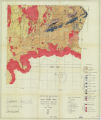| Description |
The Cove Creek area is near the eastern border of the Basin and Range province, 150 airline miles south-southeast of Salt Lake City, Utah, in the southeastern portion of Millard County, Utah. The sedimentary rocks consist of the Ordovician Pogonip Group (112')> Eureka Quartzite (l04'), and the Fish Haven Dolomite (583'); the Devonian Sevy Dolomite (183'), and the Guilmette (?) Formation (137'); the Mississippian Deseret Limestone (234'); the Pennsylvanian Oquirrh Formation (441'); the Permian Kaibab Limestone (271'); the Pliocene to early (?) Pleistocene Sevier River Formation (262'); and the Quaternary gypsum sands, gravels, and alluvium. Late Tertiary rhyolites and andesites, Pleistocene (?) vitrophyre outcrops, and Quaternary basalts cover approximately 25 per cent of the Cove Creek area. Alteration consists of (l) a postulated baked contact zone immediately underlying a Pleistocene (?) basalt and (2) deposition of oxides and hydroxides of iron in the Ordovician, Devonian, Mississippian, Pennsylvanian, and Permian strata and in the late Tertiary rhyolites and andesites. These iron deposits are postulated to be a result of late Tertiary iron-bearing solutions which moved through the rocks by means of a network of fault planes, joints, and fractures. It is postulated that the following sequence of events viiihave taken place in the Cove Creek area. (1) Regional upwarp(s) in the Cordilleran miogeosyncline during the Paleozoic Era are partially revealed today by unconformities between the Pogonip Group and the Eureka Quartzite, between the Eureka Quartzite and the Fish Haven Dolomite, between the Fish Haven Dolomite and the Sevy Dolomite, between the Guilmette (?) Formation and the Deseret Limestone, between the Deseret Lime stone and the Oquirrh Formation, and between the Oquirrh Formation and the Kaibab Limestone, (2) Uplift, folding, and thrusting occurred between the late Jurassic (?) and early Tertiary (?) and is probably Laramide. Subsequent uplift and erosion has exposed rocks as old as early Ordovician, (3) Extrusion of the hornblende rhyolite during late Tertiary time was followed by the extrusion of the augite andesite. Extrusion of the augite andesite was accompanied by iron-bearing solutions which altered the rocks along faults, joints, and fractures in the rhyolites and andesite and in the Ordovician, Devonian, Mississippian, Pennsylvanian, and Permian strata. (4) Deposition of the Pliocene to early (?) Pleistocene Sevier River Formation occurred in an early to medial Tertiary (?) tectonic basin. During the interval between late Tertiary (?) and early Pleistocene (?), volcanism occurring simultaneously with deposition of the Sevier River Formation resulted in an interbedding of basalt units I and II with the Sevier River sediments. Basalt unit III was extruded following deposition of the Sevier River Formation, but before deposition of Lake Bonneville sediments. (5) Even though normal faulting may have been continuous in this portion of the Great Basin from late (?) Miocene time, the normal faults that appear in the mapped area are postulated to have been initiated some time during late (?) Tertiary and Pleistocene (?) time. (6) Lake Bonneville developed during Pleistocene time. With desiccation of this lake, terraces were formed and gypsum sands accumulated in the Cove Creek area through evaporation of playa lakes and wind deposition. (7) The recurrence of volcanism after deposition of the gypsum sands resulted in the building of the Cove Fort volcano and extrusion of the basalts of unit IV. (8) Erosion and dissection of the older rocks with simultaneous development of post-Bonneville basalts and alluvial deposits in the southern portions of the area continued from late Tertiary time to the present. |





